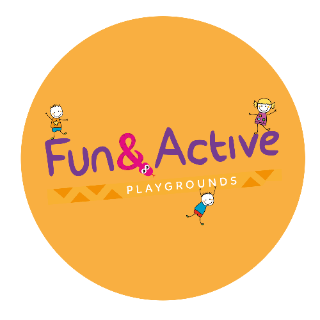Best Maths Playground Markings To Boost Learning For All
Updated on: April 11, 2023
Educational play has come a long way. Thanks to thermoplastic, you can now install exciting maths playground markings which promote national curriculum mathematics topics whilst enhancing learning for all.
Hardwearing, robust, and versatile, thermoplastic playground markings have enabled us to take maths playground designs to new heights. We now have the flexibility to create bright, fun school playground markings in any design we choose.
Offering both playground designs from our collections and bespoke commissions, we install a wide range of creative, fun school playground markings. For mathematics, we have all sorts of imaginative maths playground markings to support the development of a wide range of maths skills in stimulating ways.
Carefully planned in line with national curriculum maths targets, our maths playground designs help children of all abilities consolidate key mathematics skills.
From number bonds to multiplication, fractions, time, compass points, and subtraction, we have playground ideas to suit pupils of all ages.
Here’s our roundup of some of the best maths playground marking ideas for schools. To support learning through play in your setting, we’ve also included some maths outdoor learning activities your pupils and staff will enjoy.
Best Maths Playground Markings To Boost Learning For All
Here are some of our most popular maths playground designs for schools to give you plenty of inspiration for your own outdoor spaces. All of our existing designs can be customised to your specific requirements. Alternatively, you can order a fully bespoke design. If you have old markings in place, we can remove them before we install new ones. …more about removals
Top maths playground markings ideas: 5 reasons why they’re so popular
1. Space to consolidate learning
Having outdoor spaces with exciting maths playground designs makes it possible for pupils to revisit key maths skills in a relaxed setting.
Away from the pressures of the classroom, in their own time, pupils can casually revisit and repeat core learning at their own pace. Repeatedly engaging with maths concepts for short bursts of time gives children room to consolidate important mathematics skills.
The advancements of thermoplastic mean we are able to present key concepts within our mathematical playground markings as vibrant, appealing visual cues. Offering designs to cover a wide range of maths topics, mathematics markings provide a fresh perspective on what it means to learn maths.
Always using the national curriculum as our starting point, our designs are also great for TAs and LSAs to use with groups. Our Fractions Circle Playground Marking is a good example of this.
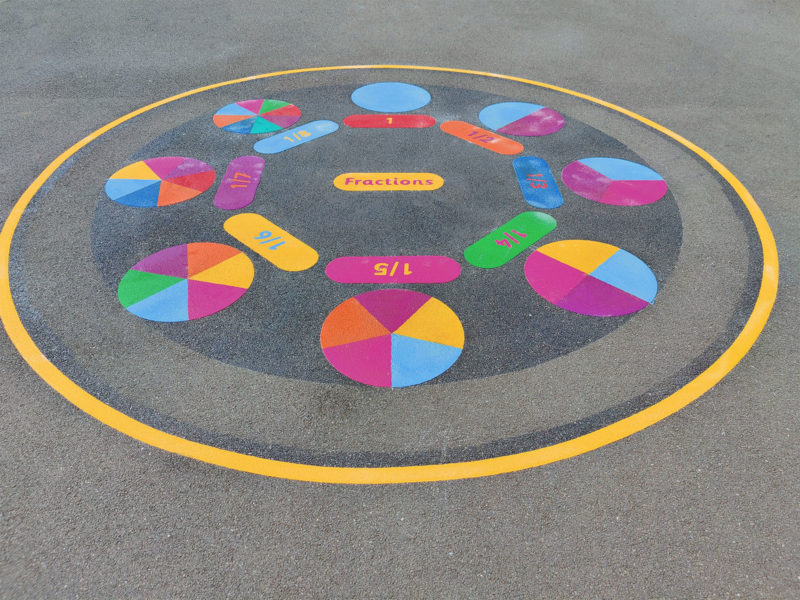
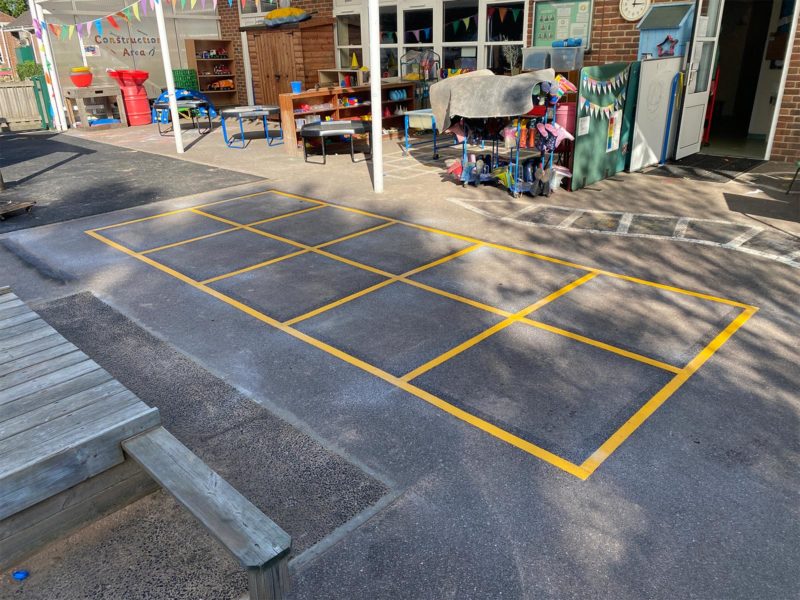
Beyond use by children at playtime, here’s an idea for how the Fractions Circle Playground Marking could also be used for a group activity led by a TA.
Maths outdoor learning activity idea: Fractions Circle Playground Marking
Objective: Practice reading and writing simple fractions
- TA calls out a fraction represented on the fractions playground design. For example, halves. Pupils run or jump (choose jumping if crowd control is needed!) to corresponding mark. Repeat for different fractions.
- TA gives each pair an instruction card and reads it to them. For example, cover 3/5 with bean bags. Each pair carries out instruction on card, shows TA, then returns card and gets a new one.
- Tell pupils they are the teacher and they need to give you instructions. TA runs to wrong fractions and covers the wrong amount of fractions. Ask pupils to come and correct your mistakes each time.
- Finish by covering part of a fraction circle and asking children to write down the fraction left. Discuss how to check if the answer is correct by adding all the fractions, both covered and uncovered, together.
See more designs ideal for consolidating learning
2. Promote core skills
With the flexibility to use our mathematical playground markings during free play, guided play and structured group activities, there’s lots of opportunity to harness the advantages of imaginative play.
Taking place in an informal, fun social setting means these play experiences are ripe for peer-learning in mixed ability groups. As they mix together during free play, pupils can engage with the core maths skills contained within the markings and extend their understanding as they casually learn from each other.
Our maths playground designs promote an array of problem-solving skills. As pupils use everything from trial and error to perseverance and analytical skills, they’ll work together to find solutions.
Creating powerful opportunities for peer learning, pupils can unknowingly correct their peer’s misconceptions and fill gaps in knowledge, all within the context of imaginative play.
Our Dartboard Playground Marking is a perfect example.
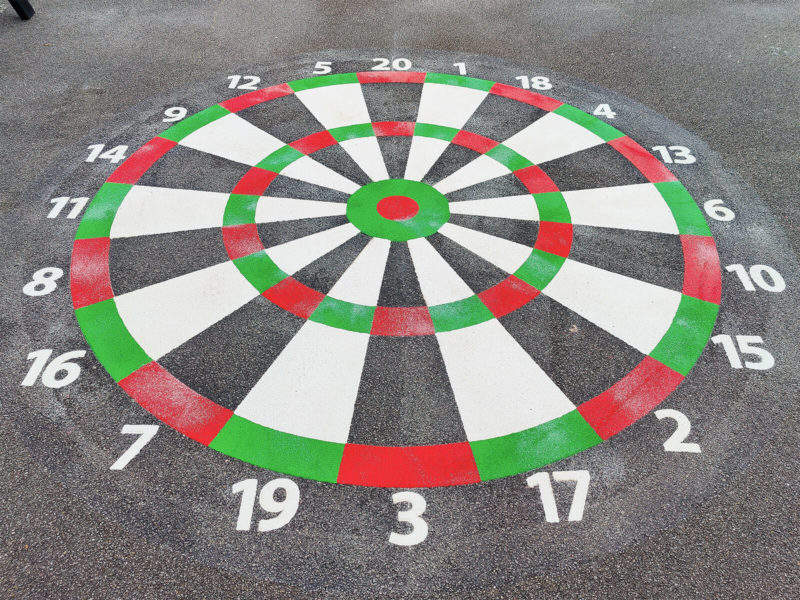
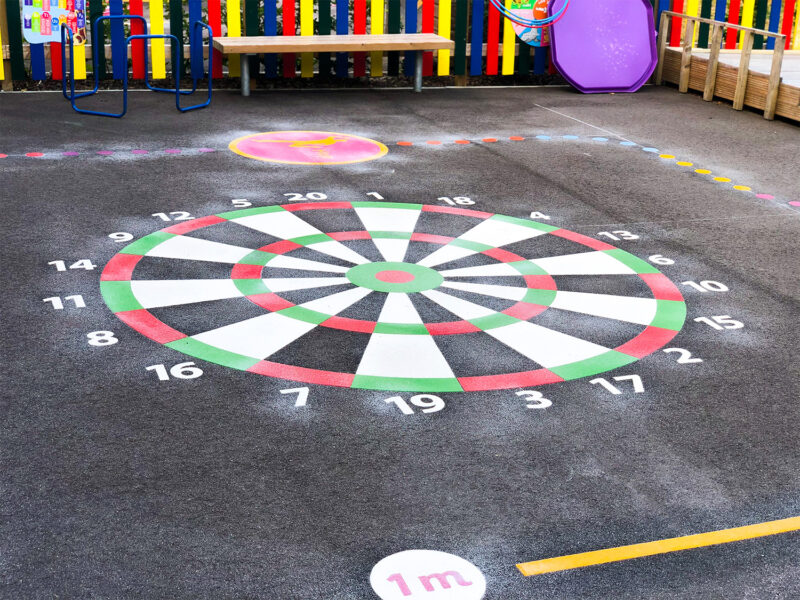
Maths outdoor learning activity idea: Dartboard Playground Marking
Objective: Practice number bonds to 20
- Say we are going to see how many different ways we can make 20. TA calls out a number from the board or stands on it. Children run or jump to the bond to make 20. Repeat.
- Split children into pairs and children repeat above as a pair. After each pair of numbers is found, the pair write the number sentence on a whiteboard.
- Ask how could you use this to help you solve subtraction from 20? Pick one pair’s whiteboard and turn the sentence around, writing the equivalent subtraction number sentence without the answer. Ask who could run to the answer on the dartboard? Children run or jump to the answer. Repeat.
3. Learning through repetition
As a permanent playground feature, our maths playground markings enable children to benefit from the advantages of repetition to aid learning.
Taking place in an open, social context means children can also develop their mathematical knowledge and understanding by copying what peers and older children are doing.
Outdoor learning during free play removes the boundaries of time and ability groupings. Conversations about core skills with peers provides pupils with valuable space to listen and explain to others to make sense of what they see.
By regularly engaging with known mathematical concepts in this way, pupils are exposed to new ways to think about key concepts, approach calculations and solve problems.
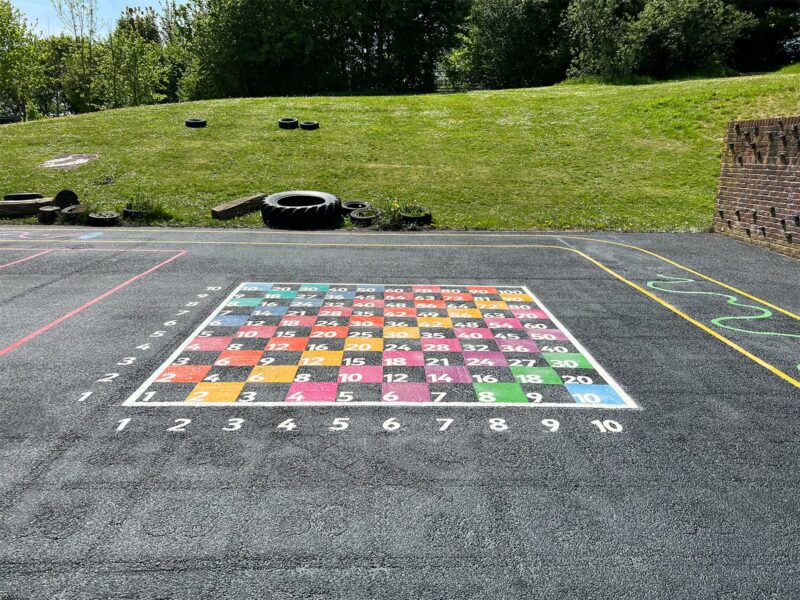
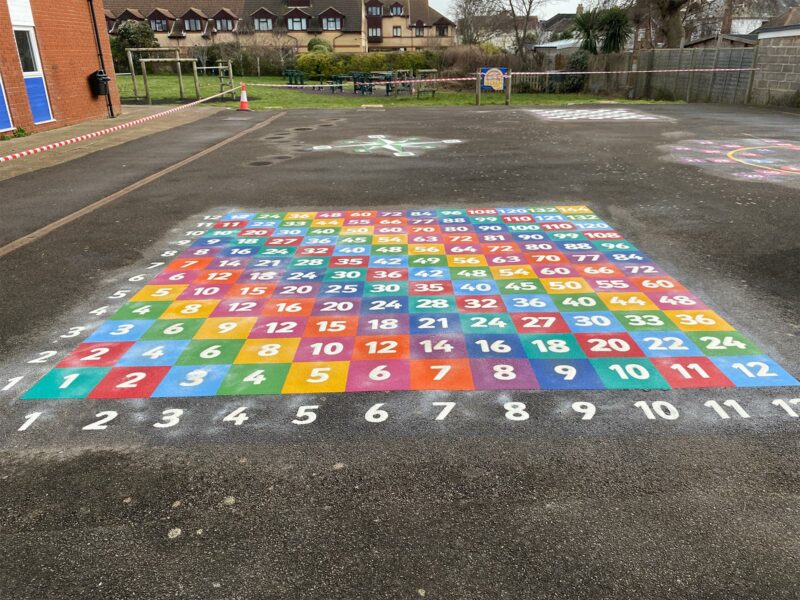
Maths outdoor learning activity idea: Multiplication Grid 1-10 Every Other Playground Marking
Objective: Recognise patterns and sequences
- Take a small group and a tray of unifix to the marking. Give each pupil some unifix and spread the pupils out around the marking.
- Call out 4 x 4. Pupils have 4 seconds to run to the correct answer and leave a unifix on it.
- Ask how do we use the grid to check. Discuss using the numbers on the x and y axis. Ask two children to demonstrate by standing on each 4 and meeting on 16.
- Ask children to return to positions and call out 6 x 6. Give them 4 seconds to place their unifix in the correct position again, remind them of the strategy. Repeat for 8 x 8.
- Discuss why we call these square numbers, using a unifix model. Go back to 16 and outline the square from 4 to 4, 16 and the corner in chalk. Get children to do the same for 36 and 72 in chalk.
- Ask children to record all the square numbers from the marking on the ground in chalk. Return to the classroom and ask children to record what they have found out today using images and notes.
See more designs ideal to promote core skills
4. Kinaesthetic learning
The constraints of the classroom can so often mean an over-reliance on maths activities which support auditory and visual learners. For a fresh approach, our mathematics playground markings provide a perfect backdrop for kinaesthetic learners.
Thermoplastic is a wonderfully hardwearing, robust material which can stand up to busy feet. Pupils can run, jump, dance and skip across our thermoplastic playground markings without fear that playground paint will be ruined.
Accompanied by bright designs in appealing colours, our markings are a wonderful way to put aside the pencil and paper for a moment and implement outdoor maths activities which support a range of learning styles.
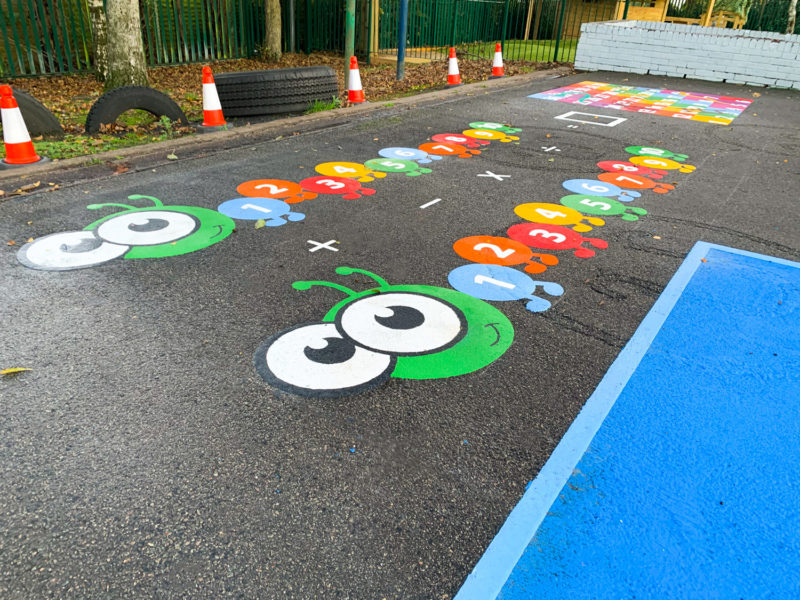
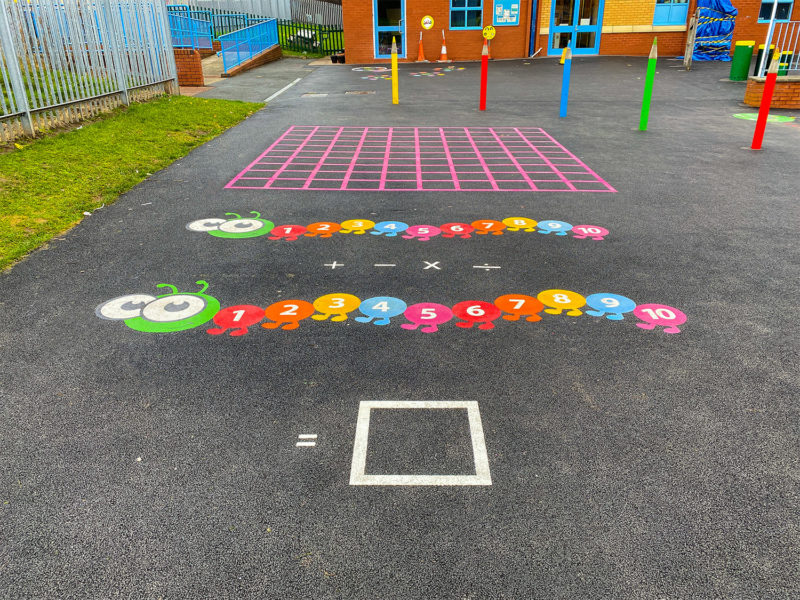
Maths outdoor learning activity idea: Maths Caterpillar 0-10 Playground Marking
Objective: Practice subtracting numbers less than 9 from 10.
For a small group of 1-3 struggling children working with a TA
1.Tell children to circle the add sign with chalk.
2. Discuss what it means using bean bags.
3. Say let’s see how many ways we can find to make 10. Put 10 bean bags in the middle.
4. Tell the children to run to one of the numbers together. Tell one of the children to stay on the number and the other two to go and get that same number of bean bags and put them on the number with them.
5. Ask; so we had 10 in the middle, how many did you take away? Ask how many are left in the middle? Say shall we see? Go to the middle and count together, dropping each bean bag to see how many are left. Ask how many are left in the middle? Jump how many are left together. Together each child writes the number sentence on a whiteboard. Repeat.
See more playground designs ideal for visual learning
5. Open-ended play
Each of our designs are carefully created to allow for open-ended play. Depicting essential maths skills in versatile ways offers infinite options for play. Able to draw on their imagination, mathematical playground markings from Fun & Active Playgrounds promote inclusive play which cuts across year groups and abilities.
From perseverance to turn-taking, children benefit from so many wider skills as they play. With no right or wrong way to play, pupils are free to engage in creative educational play in any way they choose.
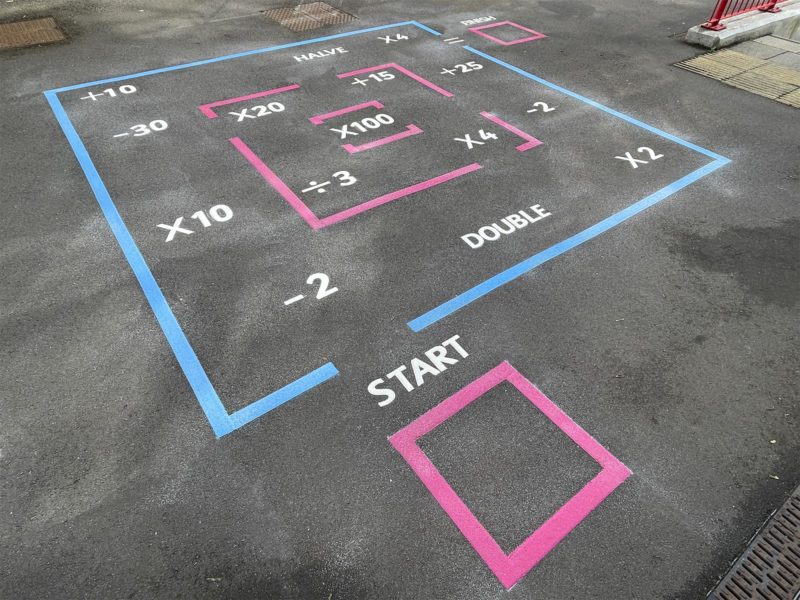
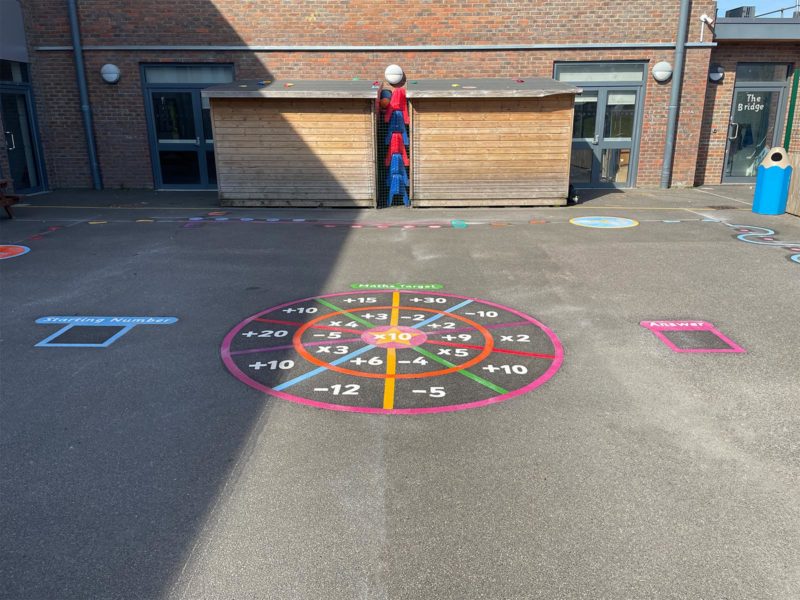
And that’s just a few of our most popular maths playground designs! Browse our full collection of mathematical playground markings. Remember all our designs are bespoke so you can commission exactly what you have in mind.

Jess Sparks
Jess is deeply committed to supporting our mission of positively impacting UK outdoor play environments to promote healthy lifestyles in children.
With a CIM Level 6 Diploma in Sustainable Marketing, Jess channels her passion for sustainability into her marketing role, using her skills to promote eco-conscious practices and raise awareness for our initiatives.
Jess’ experience within the industry is instrumental in driving engagement and supporting connections with those who require ultra-durable, high-grade playground markings both locally and internationally.
